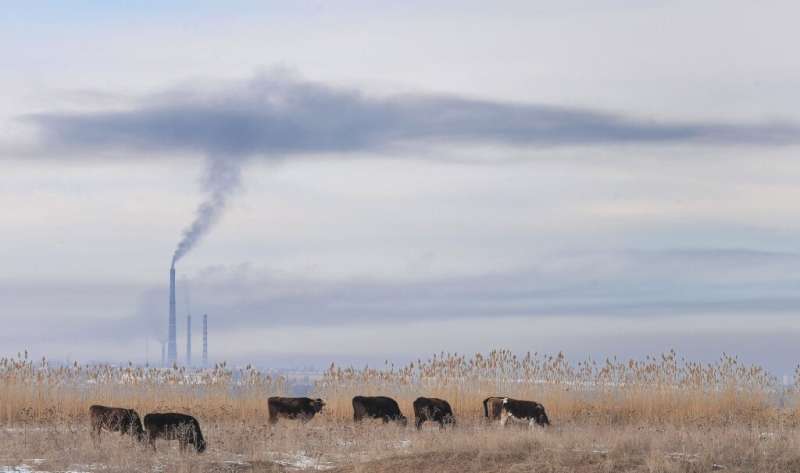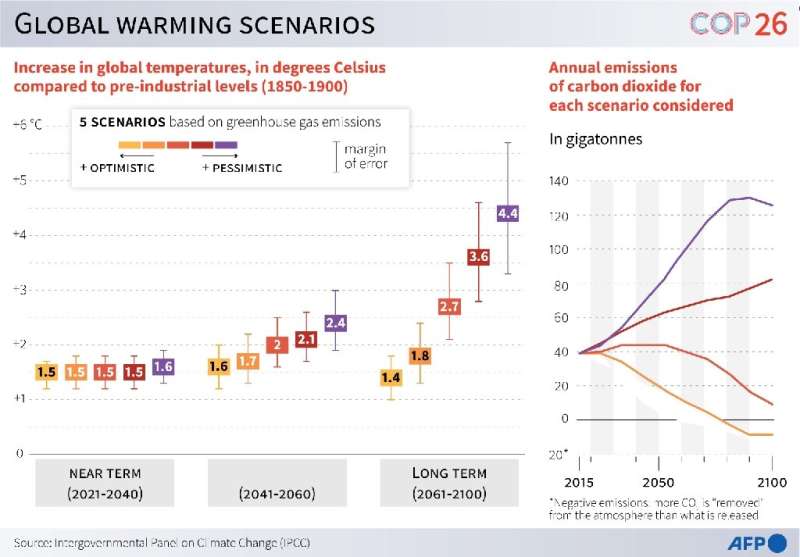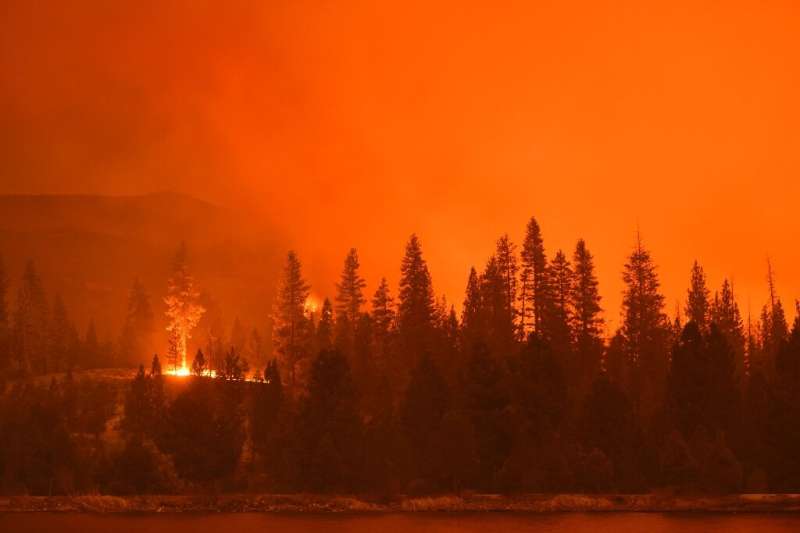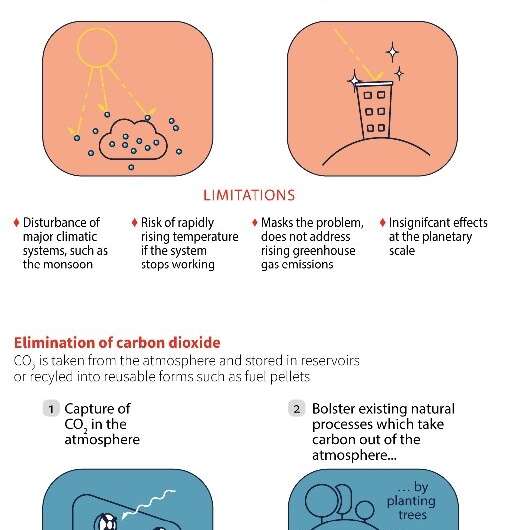Climate: Removing CO2 from the air no longer optional

The burning question going into the Glasgow climate summit is whether major economies can, by 2050, reduce emissions enough to deliver a carbon neutral world in which humanity no longer adds planet-warming gases to the atmosphere.
Less talked about—but rising quickly on the climate agenda—are tools and techniques to pull CO2 straight out of the air.
Even scientists sceptical about its feasibility agree that without carbon dioxide removal (CDR)—aka "negative emission"—it will be extremely difficult to meet the Paris Agreement goal of capping global warming below two degrees Celsius.
"We need drastic, radical emissions reductions, and on top of that we need some CDR," said Glen Peters, research director at the Centre for International Climate Research.
What is CO2 removal?
There are basically two ways to extract CO2 from thin air.
One is to boost nature's capacity to absorb and stockpile carbon. Healing degraded forests, restoring mangroves, industrial-scale tree planting, boosting carbon uptake in rocks or the ocean—all fall under the hotly debated category of "nature-based solutions".
The second way—called direct air capture—uses chemical processes to strip out CO2, then recycles it for industrial use or locks it away in porous rock formations, unused coal beds or saline aquifers.
A variation known as bioenergy with carbon capture and storage, or BECCS, combines elements from both approaches.
Wood pellets or other biomass is converted into biofuels or burned to drive turbines that generate electricity. The CO2 emitted is roughly cancelled out by the CO2 absorbed during plant growth.
But when carbon dioxide in the power plant's exhaust is syphoned off and stored underground, the process becomes a net-negative technology.

Do we really need it?
Yes, for a couple of reasons.
Even if the world begins drawing down carbon pollution by three, four or five percent each year—and that is a very big "if"—some sectors like cement and steel production, long-haul aviation and agriculture are expected to maintain emission levels for decades.
"We have modelling, but no one is sure what we might need in 2050," said Oliver Geden, a senior fellow at the German Institute for International and Security Affairs and an expert on CDR.
"There will be residual emissions and the numbers might be high."
And there is another reason.
The August report from the UN's Intergovernmental Panel on Climate Change (IPCC) makes it alarmingly clear that the 1.5C threshold will be breached in the coming decades no matter how aggressively greenhouse gases are drawn down.
CO2 lingers in the atmosphere for centuries, which means that the only way to bring Earth's average surface temperature back under the wire by 2100 is to suck some of it out of the air.
What's hot, what's not?
BECCS was pencilled into IPCC climate models more than a decade ago as the theoretically cheapest form of negative emissions, but has barely developed since.
The technology's prospects took a hit this week when Britain's large Drax Power Station, converted to run on biomass and store emitted CO2, was dropped from an investment listing of sustainable companies, the S&P Clean Energy Index.
"I don't see a BECCS boom," said Geden.

A peer-reviewed proposal in 2019 to draw down excess CO2 by planting a trillion trees sparked huge excitement in the media and among gas and oil companies that have made afforestation offsets a central pillar of their attempts to align with Paris treaty goals.
But the idea was sharply criticised by experts, who pointed out that it would require converting twice the area of India into mono-culture tree farms.
Also, planting trees to soak up CO2 is fine—until the forests burn down in climate-enhanced wildfires.
"They really have a problem in California," Geden said. "The state deals with forest offsets and emissions trading, but their forests are burning down."
Among all the carbon dioxide removal methods, direct air capture is among the least developed but the most talked about.
"It's such a sexy technology," said Peters. "Part of that is marketing—glossy brochures, a fancy technology, shiny silver. It captures the imagination."
How fast can we scale up?
In reality direct air capture (DAC) is a large-scale industrial process that requires huge amounts of energy to run.
Existing technology is also a long way from making a dent in the problem.
For example, the amount of CO2 extracted in a year by the world's largest direct air capture plant (4,000 tons)—opened last month in Iceland by Climeworks—is equivalent to three seconds' worth of current global emissions (40 billion tons).
Earlier this year a team of researchers led by David Victor at the University of California San Diego's Deep Decarbonisation Initiative wanted to see how much a "wartime-like crash deployment" of DAC could lower CO2 concentrations under different emissions scenarios.
Assuming investment of a trillion dollars a year starting now, DAC knocked off some two billion tonnes of CO2 annually from global emissions by 2050 in the models.
But only when coupled with the most ambitious carbon-cutting scenario laid out by the IPCC was that enough to bring temperatures back down—after rising to 2C—to around 1.7C by 2100.

Corporate investment?
Direct Air Capture has benefited from a wave of corporate backing.
In April, Tesla CEO Elon Musk launched the $100-million X-Prize for CO2 removal technology.
Last month, Breakthrough Energy founder Bill Gates unveiled a corporate partnership—American Airlines, ArcelorMittal, Bank of America, Microsoft, The BlackRock Foundation and General Motors—to turbocharge the development of direct air capture, sustainable aviation fuel and two other new energy technologies.
"A global carbon removal industry is coming," Johanna Forster and Naomi Vaughan, both from the University of East Anglia, noted last week in a commentary.
The danger, said Peters, is that some companies may talk up future carbon dioxide removal rather than reducing emissions today.
Impact on UN negotiations?
Appeals to remove the amount of CO2 in the atmosphere have begun to enter the political arena, and could become a contentious issue at the UN negotiations in Glasgow and beyond, experts say.
First India, then China, called earlier this year on rich countries to go beyond 2050 net-zero commitments.
"Countries from the Global South are demanding that industrialised countries go net-negative," said Geden.
Small island states whose nations are literally slipping under the waves "are dead serious about carbon dioxide removal already," he added.
For David King, chair of the Climate Crisis Advisory Group, "net-zero by 2050 is no long enough."
"We must revise global targets beyond net zero and commit to net negative strategies," he said earlier this month.
© 2021 AFP





















